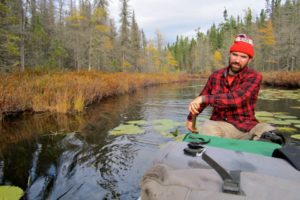 In 1915, Charlie & Petra Boostrom founded Clearwater Historic Lodge & Canoe Outfitters. This year we celebrate our centennial — 100 years of helping guests explore the beauty and tranquility of the Boundary Waters Canoe Area. In honor of our founders and their legacy, we’ve been sharing stories about the Boostrom’s and the early days of Clearwater Historic Lodge and the Gunflint Trail. Many of the stories — including the passage below — come from the delightful book, Gunflint Trailblazers – The Story of Charlie & Petra Boostrom by Beatrice Flaaten Ogren published in 1977.
In 1915, Charlie & Petra Boostrom founded Clearwater Historic Lodge & Canoe Outfitters. This year we celebrate our centennial — 100 years of helping guests explore the beauty and tranquility of the Boundary Waters Canoe Area. In honor of our founders and their legacy, we’ve been sharing stories about the Boostrom’s and the early days of Clearwater Historic Lodge and the Gunflint Trail. Many of the stories — including the passage below — come from the delightful book, Gunflint Trailblazers – The Story of Charlie & Petra Boostrom by Beatrice Flaaten Ogren published in 1977.
* * * * * *
“Activity at the lodge was varied. For instance, there were canoe trips to Ely. It would take about 6 days to guide a party to Ely where the party would return home by train. Charlie would come back to Clearwater alone; if there were two canoes ,he tied saplings between them to make them easier to steer. He had to double back on all the portages to carry the large amount of equipment. More than likely, as soon as he got back to the Lodge, there was another party waiting to go. He once guided 56 consecutive days on Mountain Lake. The summers were busy ones with many guests. During the winter he had many other things to occupy his time. The winters, certainly, are rugged in the North country but the cold was not permitted to interfere with any activities. The first thermometer at the lodge only went to 40 degrees below zero; it was broken the first winter. The next one went to 60 degrees below zerio and that, too, gave out soon after. Charlie had only one bad experience with cold weather; that was when he was covering a trap line in Canada. Going from Northern Light Lake to Saganaga along a creek, he broke through the ice. He continued four miles to an Indian’s cabin and there he thawed his frozen foot. He was not one to let a minor item like a frozen foot deter him, so he wrapped each toe in adhesive tape and continued on his way. When he arrived home he pulled the tape off and all the skin came with it. Later a doctor, who was staying at the Lodge, told him that he had done exactly the right thing, for he had removed all the dead skin under which infection could have developed. Charlie admits his foot was a bit sensitive to water all that next summer!
“I asked Charlie if he had any way of predicting the severity of a winter. He discredits the claims made by some that the thickness of an animal’s fur, etc. can be used to forecast weather. His method is one I had not heard before. In September he closesly observed the Milky Way. If it was thick and white there would be much snow. If it had holes of dark blue in it, it would be cold. He feels the porcupine is a good thermometer. He chooses a tall pine for his winter home and that pine is also his food supply. The colder the day, the higher he climbs on the pine; on the coldest days you can see him perched on the very top of the tree. When spring comes he leaves the tree and, sadly, the tree dies because of his voracious appetite.”

